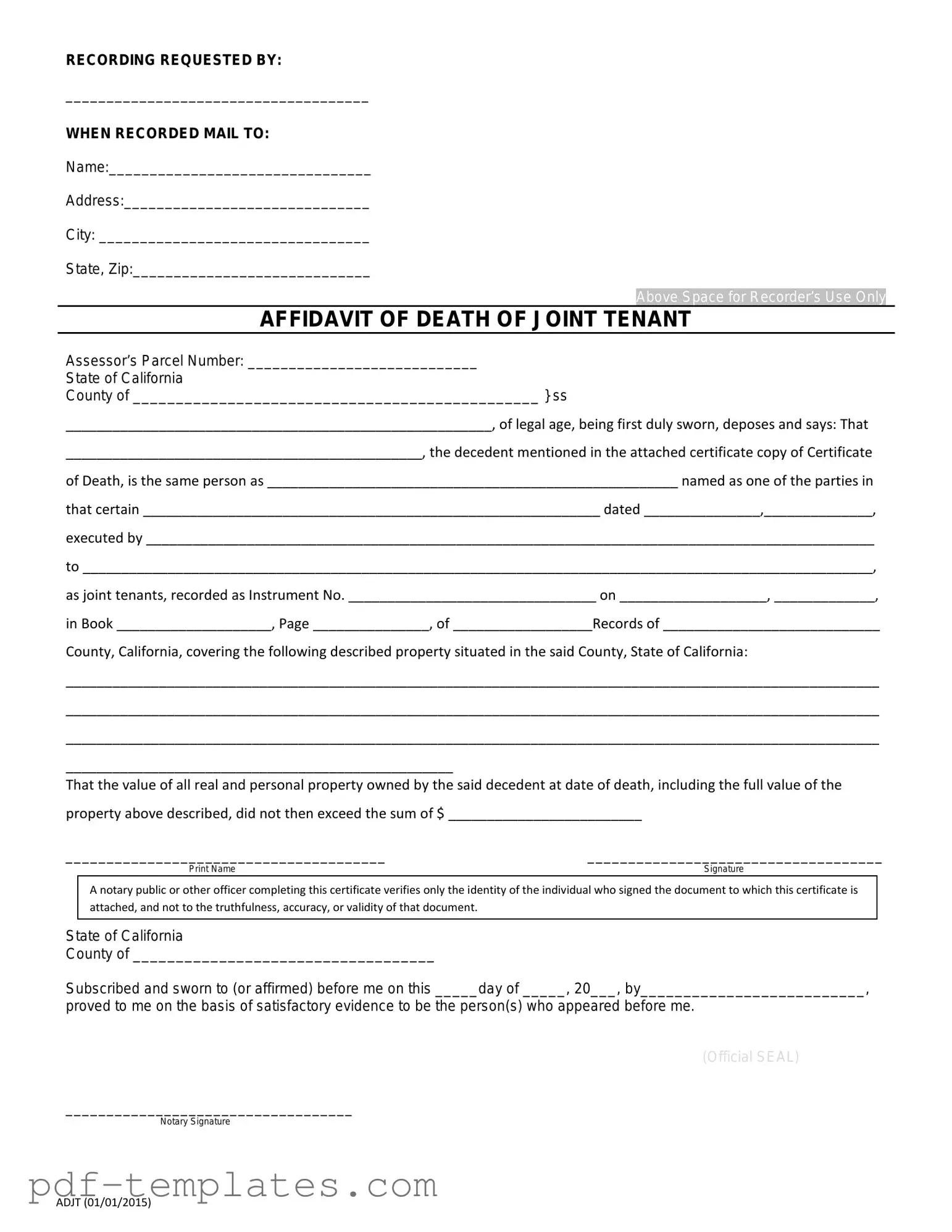The California Death of a Joint Tenant Affidavit is similar to the Affidavit of Heirship. This document is used to establish the heirs of a deceased individual when there is no will. Like the affidavit for joint tenants, the Affidavit of Heirship provides a way to transfer property without going through probate. Both documents serve to clarify ownership and facilitate the transfer process, making it easier for surviving family members to manage the deceased's estate.
Another document that shares similarities is the Grant Deed. A Grant Deed is used to transfer property ownership from one party to another. In cases where a joint tenant passes away, a Grant Deed may be used to formally transfer the deceased's interest to the surviving joint tenant. Both documents aim to simplify the transfer of property and eliminate confusion regarding ownership rights.
The Affidavit of Death is also comparable to the California Death of a Joint Tenant Affidavit. This document serves to declare the death of an individual and is often used in various legal contexts, including the transfer of assets. Both affidavits provide necessary proof of death, which is essential for updating property records and ensuring that the surviving party can claim their rightful ownership.
In addition to these property transfer documents, it is essential to consider the importance of having a California Medical Power of Attorney form. This legal document ensures that healthcare decisions can be made by a trusted individual if one is unable to do so. It guarantees that a person’s medical preferences are honored during critical times, thereby providing peace of mind. For those looking for comprehensive resources, All California Forms can offer valuable information regarding this and other essential legal documents.
The Revocable Living Trust is another document that operates similarly. A Revocable Living Trust allows individuals to manage their assets during their lifetime and specifies how those assets should be distributed upon death. Like the Death of a Joint Tenant Affidavit, this trust helps avoid probate and ensures a smoother transition of assets to the intended beneficiaries, thereby simplifying the estate management process.
The Durable Power of Attorney is also relevant in this context. While it primarily allows someone to make decisions on behalf of another person, it can also facilitate property transfers upon death. Similar to the Death of a Joint Tenant Affidavit, it ensures that the deceased's wishes are honored and that their assets are managed according to their preferences, thus streamlining the process for surviving family members.
The Will is a fundamental document that outlines how a person's assets should be distributed after death. While the Death of a Joint Tenant Affidavit directly addresses property held in joint tenancy, a Will encompasses all assets. Both documents serve to clarify ownership and ensure that the deceased's intentions are carried out, though they operate in different contexts.
The Assignment of Interest is another document that bears resemblance. This document is used to transfer a person's interest in a property or asset to another party. In the case of a deceased joint tenant, an Assignment of Interest may be necessary to formally transfer the deceased's share to the surviving tenant. Both documents facilitate the transfer of ownership and help avoid legal disputes regarding property rights.
The Certificate of Title also shares similarities with the California Death of a Joint Tenant Affidavit. This document serves as proof of ownership for real property. When a joint tenant passes away, a Certificate of Title may need to be updated to reflect the surviving tenant's ownership. Both documents are essential for ensuring that property records accurately reflect current ownership, thereby preventing potential legal issues.
Lastly, the Notice of Death serves a similar purpose. This document is used to inform relevant parties, including creditors and beneficiaries, about an individual's passing. Like the Death of a Joint Tenant Affidavit, it provides essential information that aids in the administration of the deceased's estate, ensuring that all parties are aware of the situation and can take appropriate actions.
